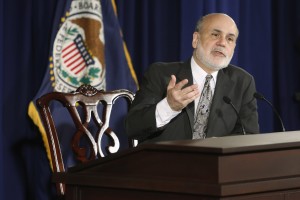By Jonathan Spicer and Jason Lange
PHILADELPHIA (Reuters) – The U.S. Federal Reserve is no less committed to highly accommodative policy now that it has trimmed its bond-buying stimulus, Ben Bernanke said on Friday in what could be his last speech as Fed chairman.
Bernanke, who steps down as head of the U.S. central bank at month’s end, gave an upbeat assessment of the U.S. economy in coming quarters. But he tempered the positive signs in the housing sector, financial markets and fiscal policies by repeating that the overall recovery “clearly remains incomplete” in the United States.
In what came as a surprise to some, the Fed decided last month to cut its asset-purchase program, known as quantitative easing, or QE, by $10 billion to $75 billion per month. It cited a stronger job market and economic growth in its landmark decision, which amounted to the beginning of the end of the largest monetary policy experiment ever.
But that decision “did not indicate any diminution of (the Fed’s) commitment to maintain a highly accommodative monetary policy for as long as needed,” Bernanke said at an American Economic Association forum in a snow-swept Philadelphia.
“Rather, it reflected the progress we have made toward our goal of substantial improvement in the labor market outlook that we set out when we began the current purchase program in September 2012,” he said.
U.S. Treasuries prices were modestly lower following Bernanke’s remarks, while U.S. stock prices were higher in light trading.
To recover from the deep 2007-2009 recession, the Fed has held interest rates near zero since late 2008. It also has quadrupled the size of its balance sheet to around $4 trillion through three rounds of massive bond purchases aimed at holding down longer-term borrowing costs.
The Fed’s extraordinary money-printing has helped drive stocks to record highs and sparked sharp gyrations in foreign currencies, including a drop in emerging markets last year as investors anticipated an end to the easing.
Looking into the years ahead, Bernanke said the central bank has the tools – including adjusting the rate on excess bank reserves and so-called reverse repurchase agreements, or repos – to return to a normal policy stance without resorting to asset sales.
“It is possible, however, that some specific aspects of the Federal Reserve’s operating framework will change,” he said, predicting the policy-setting Federal Open Market Committee would be mindful of the Fed’s swollen balance sheet as it considers adjustments.
Bernanke’s address at the downtown Philadelphia hotel attracted a standing room only audience, with many in the crowd economics students attending a conference to land jobs at the Fed and at major universities and institutions.
BALANCE SHEET SWELLS
While proponents of the Fed’s three rounds of quantitative easing since the Great Recession point to the drop in joblessness and continued positive economic growth, opponents warn that benefits have diminished in the face of threats such as a run-up in future inflation.
Charles Plosser, president of the Philadelphia Fed, said the central bank faces “immense” challenges now that it has reduced bond-buying, and needs to be cognizant of a rapid rise in prices.
Dusting off arguments he and other hawkish officials made before the recent bout of low inflation, Plosser, a voter on policy this year, said at the conference that he was less concerned about disinflation and more concerned about too-high inflation if banks start to quickly release the $2.4 trillion in excess reserves they now hold.
Richmond Fed President Jeffrey Lacker, another hawk, said, however, that the unprecedented size of the balance sheet will not keep the Fed from being able to conduct effective monetary policy.
Speaking in Baltimore, he added: “I expect further reductions in the pace of purchases to be under consideration at upcoming meetings.” Only a sharp downturn in economic data would justify putting the tapering process on hold, he said.
Last month, Bernanke, who is set to be succeeded by Fed Vice Chair Janet Yellen, said the asset purchases would likely be cut at a “measured” pace through much of this year if job gains continued as expected, with the program fully shuttered by late-2014.
To temper the long-awaited tapering of bond-buying, the Fed also said it “likely will be appropriate” to keep overnight rates near zero “well past the time” that the jobless rate falls below 6.5 percent, especially if inflation expectations remain below target.
That was a noteworthy tweak to an earlier pledge to keep rates steady at least until the jobless rate, which dropped to a five-year low of 7.0 percent in November, hits 6.5 percent.
Bernanke – who again on Friday lauded the Fed’s efforts to telegraph its intentions – said this move “reaffirmed and clarified” its plan for rates.
BRIGHTER SIGNS
Recent growth in jobs, retail sales and the housing market, as well as a fresh budget deal in Congress, has brightened U.S. prospects going into 2014. The trend has held in consumer spending as well as in manufacturing.
U.S. GDP growth hit a 4.1 percent annual rate in the third quarter, its fastest pace in almost two years. Economists generally expect between 2 and 3 percent growth for the fourth quarter, making for a solid end to the year for the world’s largest economy.
Bernanke noted unemployment remains elevated at 7 percent, and said the number of long-term unemployed Americans “remains unusually high.”
But “the combination of financial healing, greater balance in the housing market, less fiscal restraint, and, of course, continued monetary policy accommodation bodes well for U.S. economic growth in coming quarters,” he said.
“Of course, if the experience of the past few years teaches us anything, it is that we should be cautious in our forecasts.”
(Additional reporting by Luciana Lopez in Baltimore and Ann Saphir in San Francisco; Editing by Chizu Nomiyama and Andrea Ricci)















Follow Us